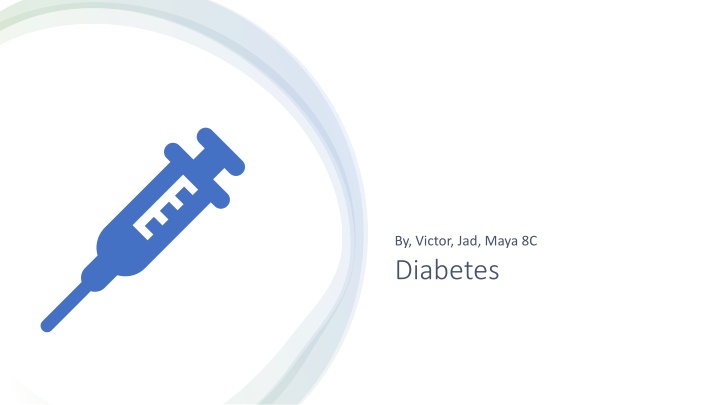
Effects and Management of Diabetes in Middle Schoolers
Learn about the effects of diabetes such as heart disease and kidney failure, how to reduce the risk through exercise and diet, common questions answered, survey statistics on exercise and diet habits, and the importance of diabetes awareness among middle school students.
Uploaded on | 0 Views
Download Presentation

Please find below an Image/Link to download the presentation.
The content on the website is provided AS IS for your information and personal use only. It may not be sold, licensed, or shared on other websites without obtaining consent from the author. If you encounter any issues during the download, it is possible that the publisher has removed the file from their server.
You are allowed to download the files provided on this website for personal or commercial use, subject to the condition that they are used lawfully. All files are the property of their respective owners.
The content on the website is provided AS IS for your information and personal use only. It may not be sold, licensed, or shared on other websites without obtaining consent from the author.
E N D
Presentation Transcript
By, Victor, Jad, Maya 8C Diabetes
What are the effects of Diabetes The effects of Diabetes are as followed: Heart disease. Blindness. Kidney failure. Nerve damage etc.
Target Audience Our target audience will be middle schoolers; grades 6-8.
How to reduce the risk of getting diabetes Exercising often / exercise regularly. Drink a minimum of 2L a water per day. Lead and maintain a healthy diet. Reducing consumption of junk food and sweets. Maintain a healthy lifestyle.
The common questions about Diabetes What is Diabetes What are the causes of Diabetes What are signs and symptoms of Diabetes How to treat Diabetes How does Diabetes affect a person's daily life
Answers to those common questions Diabetes is a disease that occurs when your blood glucose, also called blood sugar, is too high. There are many causes to diabetes but the most common are: genes, obesity, physical inactivity. The most common symptoms of diabetes are: to be very thirsty, have blurry vision, lose weight without trying, feel very tired, the need to urinate a lot. There is no way to cure diabetes but there are some ways that you can get your blood sugar levels back in range again and these ways are: healthy eating, regular exercise, weight loss, diabetes medication or insulin therapy. Diabetes affects a person's lifestyle in a negative way, in terms of school or work success, self-confidence, relationships, and many more ways.
Survey statistics: Regular exercise As we can see most survey takers exercise for more than an hour a week, but of people don t exercise so we can see that of people are regularly exercising.
Survey statistics: Diet As we can see most of the survey takers lead a healthy diet, to be exact 2 thirds of them lead a healthy diet, whereas the other survey takers do not lead a healthy diet.
Survey statistics: Knowledge about diabetes As we can see all of the survey takers know what diabetes is except 1. As we can observe most survey takers know that there are type 1 and 2 diabetes except a small handful of them.
Survey statistics: Knowledge about diabetes As we can make out a large handful of survey takers know the causes of diabetes, except a small few. As we can see the most known cause of diabetes among survey takers is genetics, unlike inadequate production of insulin which is the least known among survey takers.
Diabetes in survey takers family tree As we can see most survey takers have a diabetic in their family. As we can observe all survey takers only have 1 to 3 diabetics in their family.
Cause(s) of diabetes in survey takers family tree As we can see half of the survey takers know the cause of diabetes in their family tree while the other half doesn't The most common cause(s) in survey takers family tree are: Problems with blood sugar levels Genetics
Citation and crosschecking Slide 6 bullet point 1 Cite: U.S. Department of Health and Human Services. (n.d.). What is diabetes? - niddk. National Institute of Diabetes and Digestive and Kidney Diseases. https://www.niddk.nih.gov/health- information/diabetes/overview/what-is-diabetes Cross checking: https://www.who.int/health-topics/diabetes#tab=tab_1 https://www.diabetes.org.uk/diabetes-the-basics https://www.diabetesaustralia.com.au/about-diabetes/what-is- diabetes/
Citation and crosschecking Slide 6 bullet point 3 Cite: Centers for Disease Control and Prevention. (2023, September 7). Diabetes symptoms. Centers for Disease Control and Prevention. https://www.cdc.gov/diabetes/basics/symptoms.html Cross checking: https://www.mayoclinic.org/diseases- conditions/diabetes/symptoms-causes/syc-20371444 https://www.diabetes.org.uk/diabetes-the-basics/diabetes-symptoms https://www.webmd.com/diabetes/understanding-diabetes- symptoms
Citation and crosschecking Slide 6 bullet point 4 Cite: Mayo Foundation for Medical Education and Research. (2023, March 14). Type 2 diabetes. Mayo Clinic. https://www.mayoclinic.org/diseases- conditions/type-2-diabetes/diagnosis-treatment/drc-20351199 Cross checking: https://www.diabetes.org.uk/diabetes-the-basics/diabetes-treatments https://www.mayoclinic.org/diseases-conditions/diabetes/diagnosis- treatment/drc-20371451 https://www.webmd.com/diabetes/type-2-diabetes
